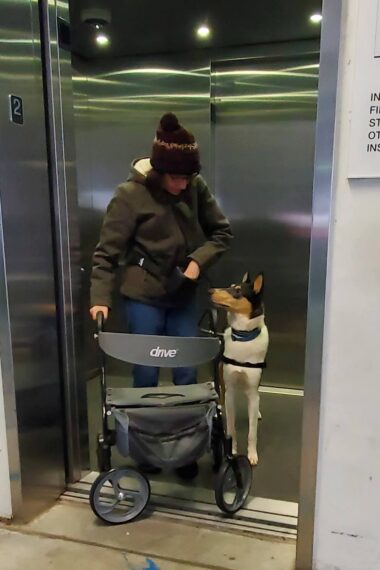Navigating public spaces with a service dog can be challenging, especially when it comes to using elevators. Elevators pose potential risks should the service dog’s leash get caught in the door or the team get accidentally separated. This makes elevator safety a critical concern for both members of the dog-handler team.
Elevators are small and confined spaces, which can be stressful for the service dog and the handler. Additionally, adaptive equipment, such as wheelchairs and walkers, can be challenging to maneuver in an elevator. Ensuring safety during the training process is important. Have a helper present during training to secure the elevator door when working with teams in training on using elevators. The service dog should always be wearing identification in case the unexpected should occur.
As with all other skills, proceeding incrementally helps build a dog’s confidence slowly. Begin by practicing entering other small spaces with the dog, such as walk-in closets or small rooms, using high-value treats. Allow the dog to watch people enter and exit elevators without initially entering. Depending on the individual dog’s confidence level, you may spend several sessions simply allowing the dog to observe. As the dog gains confidence, work toward having the dog quickly enter and exit an elevator, with a helper preventing the doors from closing. Allow the dog the opportunity to sniff and explore as well. Familiarize the dog with the area where the elevator opens so this is not a surprise. When the dog is ready (this may take several sessions for some dogs) have the team enter the elevator and ride it to the now-familiar location.
Learn how to train four tasks for PTSD:
PTSD Service Dog Task Training
The positioning of adaptive equipment requires consideration when entering an elevator with a service dog. If the client uses a scooter, wheelchair or walker, it is recommended to place the adaptive equipment on the side of the entrance from which the elevator door will emerge. This will allow the equipment to block the door and keep it open while the service dog enters. It is also important to consider the turn radius when the person with disabilities is inside the elevator. Make sure there is enough space for the adaptive equipment, the person and the service dog.
Training skills service dogs need to work safely in elevators should be practiced in other contexts first before practicing them in actual elevators. Service dogs need to be able to turn in a tight space, move forward and backward, and wait calmly. Trainers can set up spaces that simulate the size of an elevator in a training facility using chairs, agility equipment or traffic cones.
The service dog handler always needs to be ready to advocate for the needs of the dog. Trainers can teach clients that it is appropriate to decline an invitation to enter an elevator when it is crowded. The team can simply wait for the next one. Clients must be vigilant and remain focused on the dog when they use an elevator. For many service dog handlers, paying attention to the dog and the various things happening in the environment at the same time is difficult. Trainers can help clients prepare by adding in distractions slowly. For example, after the team practices entering and exiting the same elevator a few times, the trainer can interrupt the handler by asking questions about the dog.
Elevators are a common but tricky aspect of public service work, and teams in training should never rush the process of learning to navigate them successfully. With the support of a trainer and a clear understanding of the safety and logistical concerns of elevator use, service dogs and their handlers can master this important skill.

